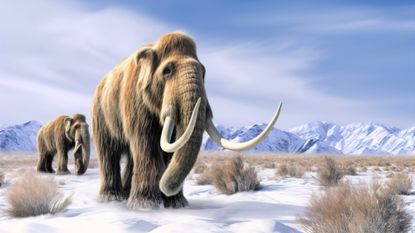A prehistoric creature has just provided a stunning breakthrough, as a new research paper reveals that scientists mapped the three-dimensional architecture of a woolly mammoth’s genome using fossilized remains. This marks the first time science has been able to fully replicate the DNA of an ancient animal from a fossil.
The paper, published July 11 in the journal Cell, is the culmination of a six-year study by an international community of scientists. The completion of the genome mapping represents a “new kind of fossil, a fossil chromosome,” said Erez Lieberman Aiden, a professor of molecular and human genetics at Baylor College of Medicine and one of the co-authors of the study, per The New York Times. This fossil could help provide more scientific enlightenments in the future.
What did the scientists do?
The fossilized remains in question were from a 52,000-year-old woolly mammoth that was found in remote Siberia. The mammoth was “impeccably freeze-dried by nature, its swatches of fur remaining intact,” said The Washington Post, likely because of the region’s harsh winters. As a result, the mammoth “probably entered a dehydrated state shortly after death, protecting it from being colonized by fungi and bacteria.”
Using one of these swatches of fur, scientists “studied a small skin sample from the back of the mammoth’s ear,” said the Post. During an examination of the hair follicles, it was discovered that the “chromosomes in each cell were still organized into clear territories, giving experts insight into which genes were switched on and off while the mammoth was alive.”
With this insight, combined with the quality of the sample, scientists were able to “extract DNA and use a technique known as Hi-C to reconstruct the three-dimensional structure of all 28 of the mammoth’s chromosomes — the extinct creature’s entire genome,” said NPR. This was not an easy task; the mammoth’s genome has more than 4 billion base pairs of DNA. The human genome, in comparison, has only 3 billion.
Scientists were “able to assemble the genome of a woolly mammoth just as 25 years ago humans were excited for the first time to assemble our own genomes,” said Aiden. Now this can be done “for animals that were long extinct. That’s obviously a milestone.”
How could this breakthrough be useful in the future?
The discovery “opens up major new possibilities of exploring the biology of extinct species,” Adrian Lister, a paleontologist at London’s Natural History Museum, said to Scientific American. It is an “astonishing study.”
One of the most notable potentials for the study is that it could open the floodgates for similar genetic information to be collected from fossilized remains. The “widespread use of the technique could generate more precise ancient genomes and allow analysis of new species,” Juan Rodríguez, a geneticist at the University of Copenhagen and co-author of the study, said to Scientific American. Putting together ancient DNA often requires a lot of guesswork, but the “new 3D structural analysis bypasses these obstacles,” meaning that “future work could flesh out evolutionary trees” or “examine how organisms adapted to their changing environments, producing insights for modern conservation efforts.”
These conservation efforts could involve assessing “how poorly or how well species are doing in terms of genetic diversity and their overall genetic health,” Patrícia Chrzanová Pečnerová, an assistant professor of evolutionary genetics at the University of Copenhagen, said to the Post. The woolly mammoth breakthrough is a good example of this, because “if we want to be able to understand what is natural, we have to go back in the past.”
Researchers “strongly believe that this is not going to apply to just the mammoth or this particular mammoth,” Olga Dudchenko, an assistant professor of molecular and human genetics at Baylor College of Medicine and another co-author of the study, said to CNN. Instead, this discovery is “basically opening up a new field that has tremendous potential.”
